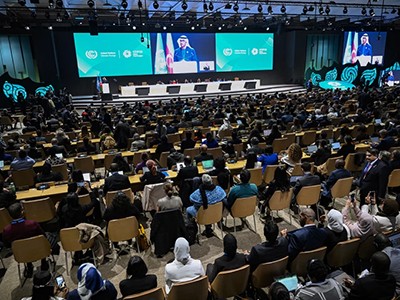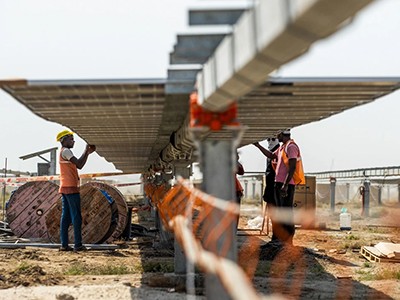As the Spanish city of Valencia recovers from devastating flash floods and southern US states mop up after two hurricanes in a month caused US$300 billion in damages, it’s clear that even the richest countries face immense costs from climate change. Those costs will only mount — unless carbon dioxide emissions are curbed worldwide.
That’s why negotiations this week at the 29th UN climate conference of the parties (COP29) in Baku are so important. Delegates must agree on the shape and scale of a system of climate finance that will help low- and middle-income countries (LMICs) to invest in decarbonization and cope with climate impacts. High-income countries (HICs), together with private donors, are expected to contribute the most — at least $2 trillion annually.
Trump’s shadow looms at climate summit: what COP29 could deliver
As a climate-finance scholar, I know that scale is the name of the game. There’s no time to wait. The Paris agreement’s limit of 1.5 °C of warming might be breached in the next 5 years if current emission rates continue. For each 0.1 °C that the planet warms above that threshold, damages will be amplified. Even a temporary overshoot is unsafe.
It’s essential that HICs recognize that it is in their own economic self-interests to scale up climate finance beyond their borders. Because warming depends on cumulative greenhouse-gas emissions in the atmosphere globally, it doesn’t matter where those gases are emitted. For example, as of 2023, the European Union has slashed its emissions by 37% since 1990 and by 8% since 2022, yet it is still facing climate damages driven by rising emissions elsewhere.
Analysis by my colleagues and I for Bruegel, a policy think tank in Brussels, shows that the benefits of paying others to decarbonize outweigh the costs, when avoided future climate damages and adaptation costs are considered (see go.nature.com/3z2gacj). Paying LMICs hundreds of billions of dollars each year saves trillions at home.
This fundamental economic case should be front and centre at COP29. Climate finance should be framed as a prudent economic choice — a win–win — rather than as just a moral obligation, which is how it is currently presented.
How to recover when a climate disaster destroys your city
The Paris agreement’s principle of “common but differentiated responsibilities” has shaped calls for HICs, given their wealth and historically greater emissions, to compensate LMICs. This approach has bogged down climate-finance debates. HICs met their 2020 commitment of paying $100 billion annually to LMICs in 2022, two years late. But only about $25 billion of that was provided in grant-equivalent investments, without repayment obligations. The rest was mainly private finance and loans with conditions.
Countries are willing to give some money for charity, but not much. As economics Nobel laureate William Nordhaus said, “Global warming is a trillion-dollar problem requiring a trillion-dollar solution, and that demands a far more robust incentive structure.” Economists know that money flows are directed by financial and economic incentives.
Nations must accept that no timely global green transition will take place without climate finance. Yes, solar panels are getting cheaper. But the solar age must come soon enough to stave off even worse climate damages in future. In sectors that can provide a revenue stream, such as renewable energy, private finance can be sought through grant-equivalent public investments.
Investments in renewable-energy sources in the next five years must be big enough to turn the tide. This means that countries should avoid emissions by replacing fossil fuels with renewable energy, rather than using such technologies to meet rising demand. And climate finance must also be available for countries to shut down fossil-fuel infrastructures and to compensate and retrain workers.
Even if HICs offer LMICs grants to pay for all of the costs of moving from coal to renewable energy, our analysis shows, the net economic benefit for wealthy nations is more than 100% — even today, paying $300 billion in damages is much more than spending $25 billion in finance.
Biases in ‘sustainable finance’ metrics could hinder lending to those that need it most
Scaled climate finance is fiscally affordable. Requiring less than 1% of a country’s gross domestic product, it can be paid for by issuing sovereign debt without increasing tax burdens. Grants should be offered instead of loans, to avoid saddling LMICs with extra debt.
Concerns about corruption should not deter offers. HICs can make payments in the subsequent year conditional on the successful abatement of emissions in the previous one.
How much is needed? In Baku, HICs need to set minimum and overall targets for different types of climate finance. At a minimum, to mitigate coal-related emissions, I recommend they offer at least $220 billion a year in public climate finance ($1.1 trillion over 2025–30), and a total of $890 billion annually to align with the Paris targets (assuming that public finance contributing 25% can motivate the private sector to provide the remaining sum). More will be needed to decarbonize emissions from other fossil fuels. Similar amounts will be needed for adaptation finance and loss-and-damage funds.
Timing is crucial. The full amount needs to be offered immediately, so that these investments can influence nations’ climate plans in 2025, when pledges to the Paris agreement will be reviewed and updated. Without sufficient funds, LMICs will feel that they have neither the moral responsibility nor the wealth to implement the agreement. We will all suffer the consequences.
Competing Interests
The author declares no competing interests.





